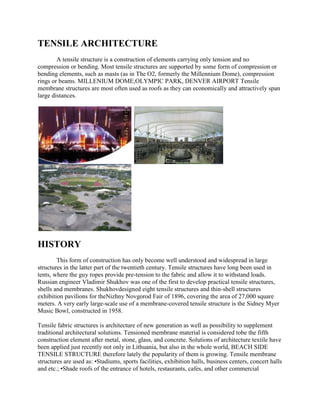
Tensile architecture
- 1. TENSILE ARCHITECTURE A tensile structure is a construction of elements carrying only tension and no compression or bending. Most tensile structures are supported by some form of compression or bending elements, such as masts (as in The O2, formerly the Millennium Dome), compression rings or beams. MILLENIUM DOME,OLYMPIC PARK, DENVER AIRPORT Tensile membrane structures are most often used as roofs as they can economically and attractively span large distances. HISTORY This form of construction has only become well understood and widespread in large structures in the latter part of the twentieth century. Tensile structures have long been used in tents, where the guy ropes provide pre-tension to the fabric and allow it to withstand loads. Russian engineer Vladimir Shukhov was one of the first to develop practical tensile structures, shells and membranes. Shukhovdesigned eight tensile structures and thin-shell structures exhibition pavilions for theNizhny Novgorod Fair of 1896, covering the area of 27,000 square meters. A very early large-scale use of a membrane-covered tensile structure is the Sidney Myer Music Bowl, constructed in 1958. Tensile fabric structures is architecture of new generation as well as possibility to supplement traditional architectural solutions. Tensioned membrane material is considered tobe the fifth construction element after metal, stone, glass, and concrete. Solutions of architecture textile have been applied just recently not only in Lithuania, but also in the whole world, BEACH SIDE TENSILE STRUCTURE therefore lately the popularity of them is growing. Tensile membrane structures are used as: •Stadiums, sports facilities, exhibition halls, business centers, concert halls and etc.; •Shade roofs of the entrance of hotels, restaurants, cafes, and other commercial
- 2. buildings; •Airport roofs, bus, train stations and terminals, car parking and gas stations; •Other permanent or temporary TENSILE POOL ENCLOSURE structures. COMMON MISCONCEPTIONS Fabric structure cannot take heavy weather conditions. Fabric is elastic and stretches. Fabric has a strong tensile strength and will creep (stretch very slightly) only a few percent over 20 years of use. ADVANTAGES DISADVANTAGES Unique designs Little to no rigidity Lightweight and flexible Loss of tension is dangerous for stability Environmentally sensitive High strength weight ratio TYPES OF FABRIC STRUCTURES SADDLE ROOF -Four or more point system when the fabric is stretched between a set of alternating high and low points MAST SUPPORTED-Tent - like structures containing one or more peaks supported by poles (masts) or a compression ring that connects the fabric to the central support. ARCH SUPPORTED-Curved compression members are used as the main supporting elements and cross arches are used for lateral stability. ALUMINUM FRAME SUPPORT COMBINATIONS-Combination of several support types. Construction materials For external use there are two main choices – i) PVC (Poly Vinyl Chloride) coated polyester cloth ii) PTFE(Poly Tetra Fluoro Ethylene) [Teflon] coated glass cloth iii) Tedlar coated polyester and iv) iv)Silicone coated glass For Interiors there are i. Silicone coated glass cloth ii. PVC coated glass mesh iii. Polyurethane coated glass cloth. COMPONENTS BASE PLATE-Connection to concrete foundation pillar MAST SUPPORTED BALE RING / MEMBRANE PLATE- Provide a link between the membrane and structural elements. Bale rings are used at
- 3. the top of conical shapes. Membrane plates accept centenary cables and pin connection hardware. MEMBRANE Forms the enclosure of the structure. Connections can be glued or heat welded. MEMBRANES PVC coated polyester (polyvinylchloride) Silicon coated glass Teflon coated glass P.T.F.E (polytetrafluroethylene) TYPES OF FABRIC MEMBRANES PVC Less expensive 15 to 20 year life span SILICON GLASS Easy to erect Higher tensile strength Brittle, subject to damage from flexing 30+ year life span TEFLON GLASS Similar to silicon glass, less brittle. ENVIRONMENTAL IMPACT Longer life cycles of materials. Materials can be re-used in form. Most materials are completely recyclable. Less impact on site. Less construction debris after demolition.
